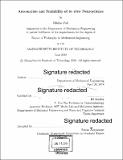Automation and scalability of in vivo neuroscience
Author(s)
Pak, Nikita
DownloadFull printable version (15.28Mb)
Other Contributors
Massachusetts Institute of Technology. Department of Mechanical Engineering.
Advisor
Ed Boyden.
Terms of use
Metadata
Show full item recordAbstract
Many in vivo neuroscience techniques are limited in terms of scale and suffer from inconsistencies because of the reliance on human operators for critical tasks. Ideally, automation would yield repeatable and reliable experimental procedures. Precision engineering would also allow us to perform more complex experiments by allowing us to take novel approaches to existing problems. Two such tasks that would see great improvement through automation and scalability are accessibility to the brain as well as neuronal activity imaging. In this thesis, I will describe the development of two novel tools that increase the precision, repeatability, and scale of in vivo neural experimentation. The first tool is a robot that automatically performs craniotomies in mice and other mammals by sending an electrical signal through a drill and measuring the voltage drop across the animal. A well-characterized increase in conductance occurs after skull breakthrough due to the lower impedance of the meninges compared to the bone of the skull. This robot allows us access to the brain without damaging the tissue, a critical step in many neuroscience experiments. The second tool is a new type of microscope that can capture high resolution three-dimensional volumes at the speed of the camera frame rate, with isotropic resolution. This microscope is novel in that it uses two orthogonal views of the sample to create a higher resolution image than is possible with just a single view. Increased resolution will potentially allow us to record neuronal activity that we would otherwise miss because of the inability to distinguish two nearby neurons.
Description
Thesis: Ph. D., Massachusetts Institute of Technology, Department of Mechanical Engineering, 2018. Cataloged from PDF version of thesis. Includes bibliographical references (pages 121-124).
Date issued
2018Department
Massachusetts Institute of Technology. Department of Mechanical EngineeringPublisher
Massachusetts Institute of Technology
Keywords
Mechanical Engineering.